Onsen bathing is a typical cultural feature of the land of the rising sun and is developing in Vietnam. If you want to experience it, you should go to AMARE – the largest health care complex in the city to enjoy Japanese standard Onsen bathing service right in the heart of downtown Hanoi.
What is Onsen? History of Onsen
What is Onsen?
Onsen in Chinese is read as “Ôn tuyền”. “Ôn” means warm and hot. “Tuyền” means stream. Onsen is a hot mineral bath or natural hot spring bath that contains many minerals that are beneficial for health.
There are two main types of Onsen baths: indoor baths or outdoor baths. The bath are also designed as private or public. Onsen bathing is a Hydrotherapy method that is loved by many people.
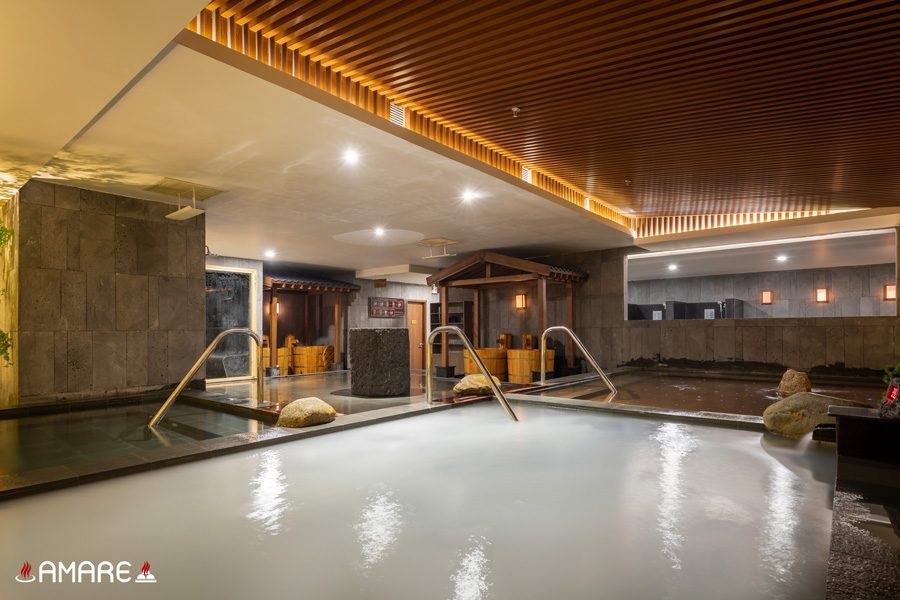
History of Onsen
The people of Phu Tang are blessed with many hot springs due to underground water sources that flow from the mouths of still-warm volcanoes. However, many central areas of Tokyo still have hot springs despite being far from volcanoes, So many experts to believe that this is warm water heated from the Earth’s core.
Mizuburo is a type of cold bath used after Onsen bathing. When Mizuburo is mentioned, many Japanese people will immediately know of the story of Samurai Minamoto no Yoshitsune. While fighting the enemy, he was seriously injured and unable to continue fighting. Just when all hope seemed lost, he suddenly saw a Mizuburo bath.
He jumped into the cold immersion bath and felt healthy again. After recovering, he continued to fight. Finally, this Samurai won the battle and became a national hero.
Japanese people often consider Onsen bathing not only a normal bathing activity but also a spiritual experience. During the bathing process, they usually keep silence to fully enjoy the relaxing feeling.
The benefits of Onsen mineral bathing
There are many benefits to Onsen bathing, however, the main effects are focused on physical recovery, mental healing, and beauty care.
In a study in Australia, scientists found that bathing in natural hot minerals twice a week for 3 months will help reduce symptoms of the knee and hip arthritis
When taking an Onsen bath, the water pressure will affect the vessel walls and muscle bundles, helping blood circulation, reducing pain, fatigue, and numbness in the limbs. The temperature in the Onsen tank helps pores expand and sweat, thereby detoxifying the body well.
Due to the process of soaking in warm water, combined with breathing and relaxing in the water, the skin of customer will continuously absorb beneficial minerals. From there, the skin will be moist, rosy, and firm from deep inside within the body.
In Japan, The Hot Spring Law defines an onsen as water that gushes out of the earth and meets the prescribed amount of chemical components of Law in 1948. The law requires that Onsen spring water must have a temperature of 25 degrees or greater and must contain at least 1 of 19 minerals such as chloride salt, sulfur…
This is also the reason why Japanese people, especially women, not only have an ideal lifespan, but they also have incredibly youthful skin and figure no matter what age they are.
Why should you put a towel on your head when bathing in hot mineral Onsen?
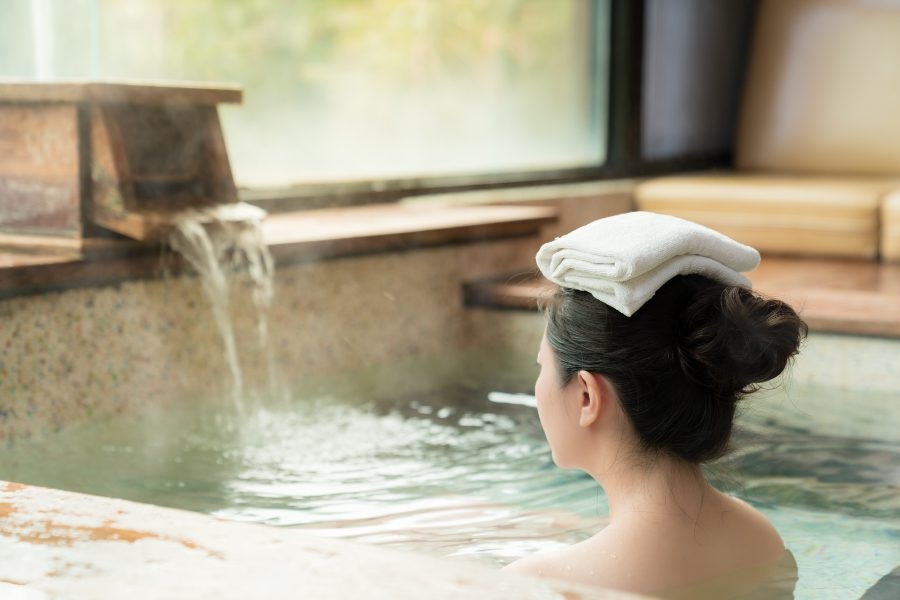
In Japanese culture, keeping your head warm by put towel when bathing in hot mineral water is considered respectful of others and it’s also a rule for maintaining the general hygiene of the bathing area.
Japanese people like to keep everything intact and natural, so with Onsen hot springs, it’s the same. Using a towel helps avoid spreading impurities into the mineral tank.
Moreover, put a towel on your head also helps keep your forehead warm, minimizes temperature differences, prevents dizziness when bathing for a long time, and provides a more comfortable and safe Onsen bathing experience.
What time and age is suitable for Onsen bathing?
Suitable time
Onsen bath is suitable for 4 seasons of the year. However, winter is still considered the most ideal time to experience this type. When the weather gets cold, blood vessels have to constrict to keep the body warm, poor blood circulation causes many problems related to bones and joints to increase.
Therefore, soaking in hot water widened pores due to the physical properties of water (expands when hot, contracts when cold), thereby stimulating the process of quickly eliminating toxins. At the same time, the pressure of the water creates a natural massage effect on the body, stimulating flexible contractions of blood vessel walls, enhancing blood circulation, especially to the brain.
Onsen bathing not only brings a clear mind and relaxed mood but also helps reduce stress and anxiety.
Suitable Age
Onsen bathing is suitable for all ages. For the elderly, the minerals in hot water help strengthen the immune system, improve resistance, and prevent some common problems related to cardiovascular or respiratory issues in old age.
For people of working age, when they often think under stress, Onsen bathing helps to create relaxation, comfort, thereby increasing work productivity. For women, Japanese-style mineral bathing helps to have beautiful skin and a slimmer body.
“In Japan, it is not difficult to see parents taking their young children to Onsen bathing. The hot mineral water has a neutral pH level that is suitable for all skin types and is appropriate for all people and ages “
Experience Japanese-standard Onsen bathing at AMARE
You don’t need to go to the land of cherry blossoms, you also have the opportunity to experience Onsen bathing in Hanoi when you come to AMARE – the first Japanese & Korean standard health care complex in downtoe Hanoi with an area of nearly 3,000m².
Located on the 3rd floor, Building B, Thang Long Number One Building (289 Khuat Duy Tien, Hanoi), AMARE is a place that fully converges the conditions for those who want to balance, relax to get rid of worries, and regenerate positive energy.
At AMARE, the Onsen bathing area is separated for men and women, including a full range of standard Japanese-style baths and saunas: Mineral bath, Silk Bath, Cold Bath. In addition, these Onsen areas are also equipped with 2 sauna rooms: dry sauna and wet sauna.
Mineral bath
Mineral bath is a hydrotherapy treatment that has been recognized for thousands of years. The benefits of hot minerals are improving symptoms of bone and joint pain, arteries, promoting blood circulation and reducing stress. The hot mineral baths at AMARE have an operating temperature of 41 – 42°C.
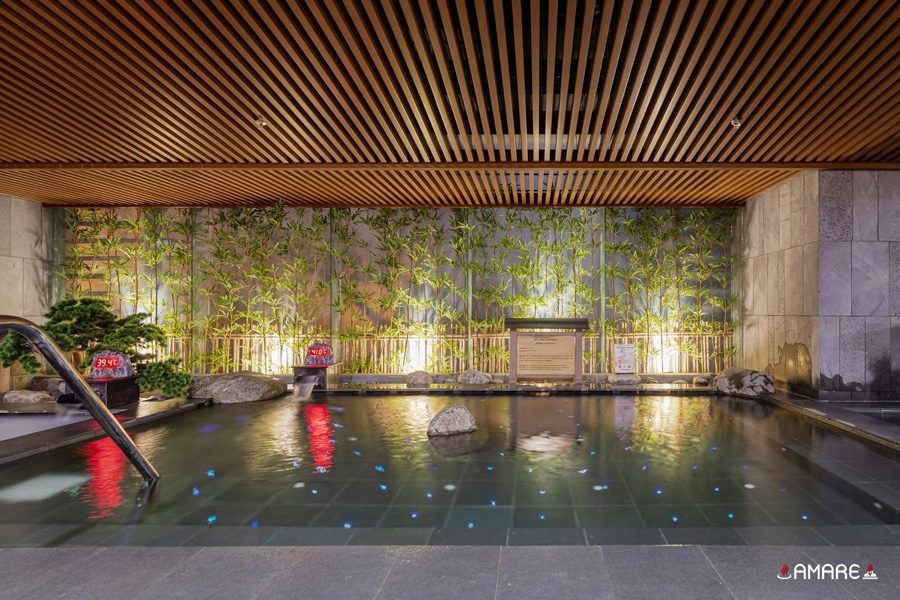
The water is heated using natural geothermal energy technology and minerals are replaced regularly every week. Each type of mineral has its own benefits. The minerals being used in the Onsen bath at AMARE can be mentioned as: hinoki wood mineral, cherry blossom sakura mineral, yuzu mineral,…
Silk Bath
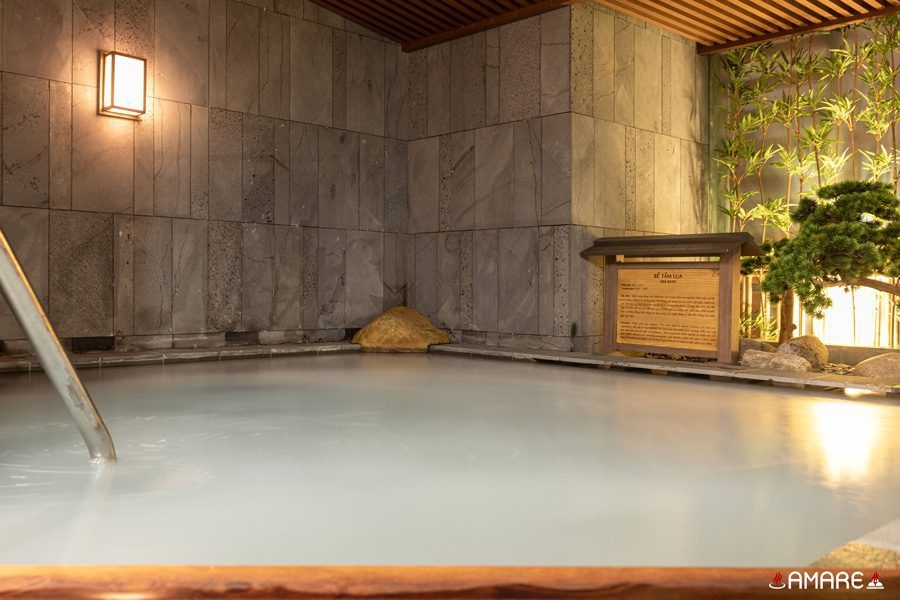
The temperature of the silk bath ranges from 39-40°C. The water in the silk bath is milky white instead of clear like normal water because it is mixed with micro-bubbles, which makes the water look soft and silky like strips of silk.
The micro-bubbles not only make the water feel smooth and silky, but also penetrate deep into the pores, helping to remove odorous substances, suck and push impurities on the skin, bringing smooth and youthful skin. In addition, the silk bath also helps bathers to relax and unwind, improve sleep quality, and sleep better and deeper
Cold Bath
Cold Bath has a temperature of 15 – 16°C. Taking a cold shower helps improve blood circulation and leaves you feeling refreshed and alert. While hot water opens the pores, cold water will complete the cleansing process by tightening the pores again.
Japanese-style onsen bathing process at AMARE
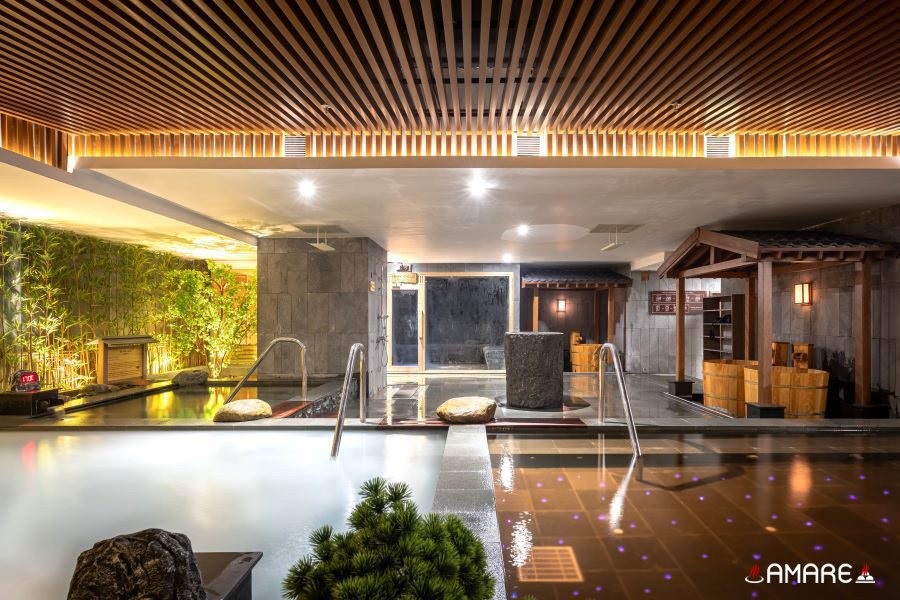
Nowadays, Onsen bathing has become a new trend. This phrase is mentioned so much that it has become familiar to those who love traveling. However, the hot mineral bath model is still new to most Vietnamese people, and not everyone understands the bathing process
At AMARE, customers will go through 5 specific steps:
Step 1: Prepare
Before entering the bathing area, you need to fulfill the requirements:
- Store personal items and clothes in a separate locker that numbered on the key that the receptionist gave you.
- Shower with soap thoroughly before entering the plunge pool.
- Use the small towel provided to cover your private parts
Step 2: Take a shower
Before entering the Onsen mineral bath area, customers need to follow some rules about bathing as follows: Bathing thoroughly from the feet – the place farthest from the heart helps you adapt to hot water and reduce stress.
Step 3: Soak your feet and soak half your body
Please quiet and gentle when entering the plunge pool. Start with “Ashiyu” – soaking in hot water from the feet, then soaking in “Hanshinyoku” – soaking up to the belly so that your body gradually gets used to the temperature of the bath, this helps you avoid dizziness or vertigo.
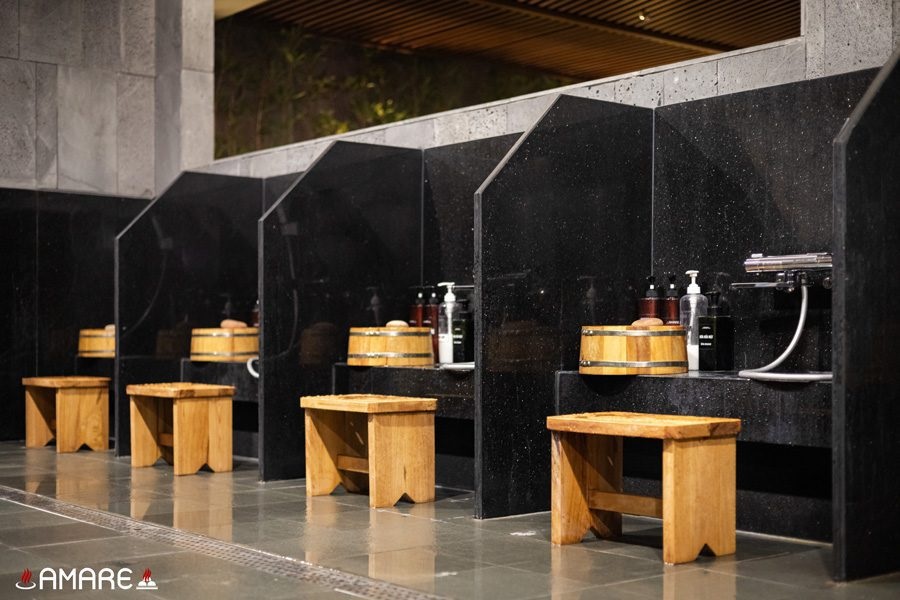
Step 4: Onsen bath
After your body has acclimated to the hot water by soaking your feet or immersing half of your body, go ahead and immerse your entire body. At this point, you can experience soaking freely in your preferred way. You can alternate between the hot bath and the cold bath. Note: make sure your body is warm enough before moving to the cold bath.
Customers can refer more about the Onsen bathing process at AMARE as follows:
Process 1: Silk bath – Mineral bath – Wet sauna – Warm water – Cold bath.
- Silk bath: Soak for 10 minutes
- Mineral bath: Continue soaking for 10 minutes.
- Wet sauna: Switch to steam for 10 minutes.
- Warm water: Rinse your body with warm water
- Cold bath: Soak for 2 minutes
Process 2: Wet Sauna – Dry sauna – Warm water – Cold bath
- Wet Sauna
- Dry sauna
- Warm water
- Cold bath
Step 5: After shower
Soaking in an Onsen is not just a regular bathing process but also aids in healing the body through natural methods. Therefore, after bathing, in Japanese culture, there is often a focus on the recovery process. Bath-goers typically replenish fluids, relax, and rest before leaving. Hydrating the body is crucial as the soaking and steaming process can lead to a significant loss of fluids.
Here are some notes when using the mineral bath service at AMARE:
Listen to your body to adjust the appropriate Onsen bathing time. It’s advisable to divide your soaking time into multiple sessions and avoid prolonged immersion in cold baths. Additionally, you can moisten your face with warm water before entering a dry or wet sauna to allow the sauna’s heat to interact with water before reaching your skin. This helps protect your facial skin and reduces the sensation of heat.
Moreover, it is advisable not to have an overly full or empty stomach when bathing in the hot springs. You can enjoy Vietnamese-Japanese-Korean cuisine at the restaurant or grab a light snack at the bar within the Thermal Therapy area at AMARE.
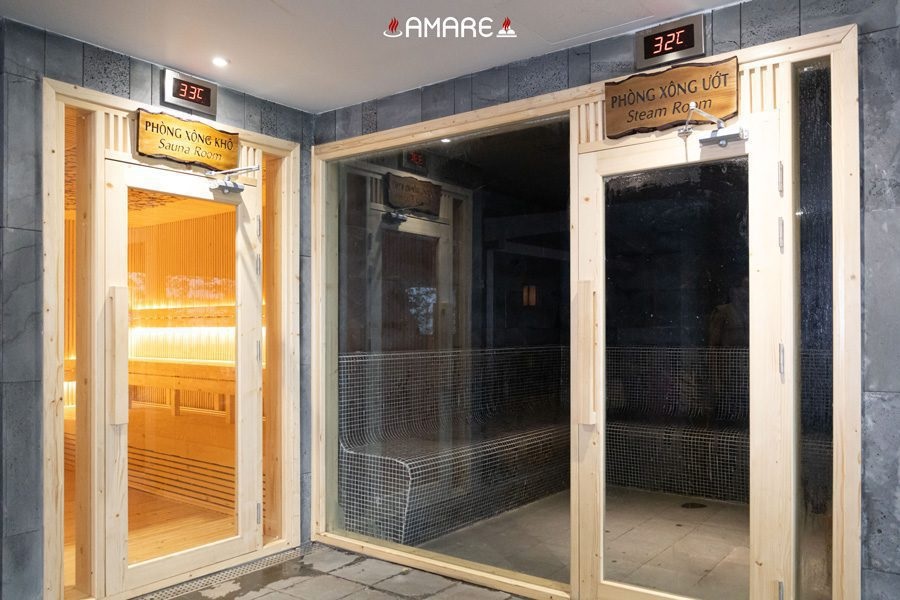
The cost of bathing at Onsen AMARE
The Onsen bathing service at AMARE offers affordable pricing suitable for many people. When purchasing a ticket for the traditional Japanese Onsen experience, you can also enjoy additional services, such as the Korean-style Jjimjilbang sauna, featuring 9 diverse sauna rooms (including Ganbanyoku sauna , Volcanic rock sauna, Infrared cave, etc.).
Not only does AMARE provide a complete range of baths and sauna rooms following both Japanese and Korean styles, but it also impresses customers with its minimalist, modern design infused with the essence of East Asian culture. The well-trained staff is always ready to serve with dedication and professionalism.
AMARE is the ideal choice for customers seeking comprehensive health care services. If you want to experience hot spring bathing in Hanoi, you can contact the hotline at 0969 800 855 for detailed assistance.




